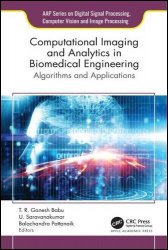Computational Imaging and Analytics in Biomedical Engineering: Algorithms and Applications
- Добавил: literator
- Дата: 22-03-2024, 22:13
- Комментариев: 0
 Название: Computational Imaging and Analytics in Biomedical Engineering: Algorithms and Applications
Название: Computational Imaging and Analytics in Biomedical Engineering: Algorithms and ApplicationsАвтор: T.R. Ganesh Babu, U. Saravanakumar, Balachandra Pattanaik
Издательство: Apple Academic Press/CRC Press
Серия: AAP Series on Digital Signal Processing, Computer Vision and Image Processing
Год: 2024
Страниц: 356
Язык: английский
Формат: pdf (true)
Размер: 27.9 MB
This new book focuses on mathematical and numerical methods for medical images and data. The book presents the various mathematical modeling techniques, numerical analysis, computing and computational techniques, and applications of machine learning for medical images and medical informatics. It also focuses on programming concepts using MATLAB and Python for medical image and signal analytics. The volume demonstrates the use of computational techniques and tools such as Machine Learning, deep neural networks, Artificial Intelligence (AI) and human-computer interaction ,fusion methods for CT and pet images, etc., for diagnosis of brain disorders, cervical cancer, lung disease, melanoma, atrial fibrillation and other circulatory issues, dental images, diabetes, and other medical issues.
For further simplification and optimization, emerging techniques such as neural networks, Machine Learning, Deep Learning (DL), and Artificial Intelligence (AI) are adapted for feature extraction of medical images, medical image segmentation, and image-based bio-models.
Image categorization, object identification, pattern recognition, and reasoning are just a few of the principles that are examined in medical imaging. By extracting meaningful patterns for a specific condition, they are employed in medical imaging to improve accuracy. They also aid in the process of deciding on a course of action. Using Machine Learning to improve medical imaging is a trend that will continue in the future. Machine Learning approaches in medical imaging are the focus of this chapter’s discussion. Machine Learning is a must-know for medical imaging professionals. We intended to give researchers a framework for understanding existing medical imaging approaches, highlighting the benefits and shortcomings of these algorithms, and discussing future prospects.
“It is thrilling to see what Machine Learning can do for the area of Computer Science and engineering. As a subfield of Artificial Intelligence, it promotes the extraction of meaningful patterns from instances, which is an essential component of human intelligence.” To educate a computer system to think like an expert, machine learning methods are essential. The goal of Machine Learning research is to give computers the ability to learn on their own. For example, a computer may collect patterns from data and then analyze them on its own for autonomous reasoning in this domain. Medical imaging is a fast expanding study field that is used to identify and cure diseases early. Based on certain expectations, digital image processing has a major impact on decision-making procedures. There are two subdomains of Artificial Intelligence: Machine Learning and Deep Learning. To achieve Machine Learning (ML), AI, and Deep Learning (DL) all require the same methodologies, which in turn are used to achieve AI.
The following open source tools are all free and available for building and maintaining your own sentiment analysis infrastructures and other NLP systems. However, do keep in mind that in order to make use of the tools below, you or someone on your team will need the necessary programming and development skills to handle the coding and ML integration.
NLTK: This includes lexical analysis, named entity recognition, tokenization, PoS tagging, and sentiment analysis. It also offers some great starter resources.
Spark NLP: Considered by many as one of the most widely used NLP libraries, Spark NLP is 100% open source, scalable, and includes full support for Python, Scala, and Java. You’ll find a whole host of NLP features, pre-trained models and pipelines in multiple languages. There’s also an active Slack community for discussion and troubleshooting.
TextBlob: Built on the shoulders of NLTK, TextBlob is like an extension that simplifies many of NLTK’s functions. It offers an easy to understand interface for tasks including sentiment analysis, PoS tagging, and noun phrase extraction. TextBlob is a recommended Natural Language Processing tool for beginners.
Doccano: This open source text annotation tool has been designed specifically for text annotation. It allows for the creation of labeled data for sentiment analysis, named entity recognition, and text summarization. This is a good option to look at for smaller datasets and building initial proof of concept projects.
Скачать Computational Imaging and Analytics in Biomedical Engineering: Algorithms and Applications
[related-news] [/related-news]
Внимание
Уважаемый посетитель, Вы зашли на сайт как незарегистрированный пользователь.
Мы рекомендуем Вам зарегистрироваться либо войти на сайт под своим именем.
Уважаемый посетитель, Вы зашли на сайт как незарегистрированный пользователь.
Мы рекомендуем Вам зарегистрироваться либо войти на сайт под своим именем.
